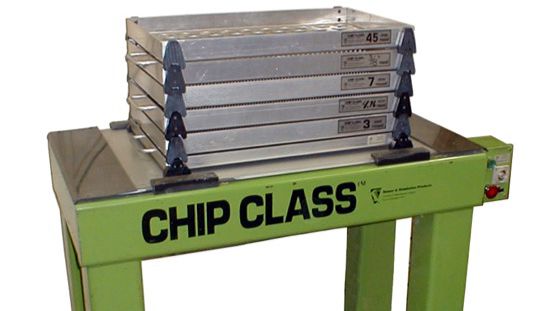Designed for testing and demonstrating Acrowood equipment on customer materials
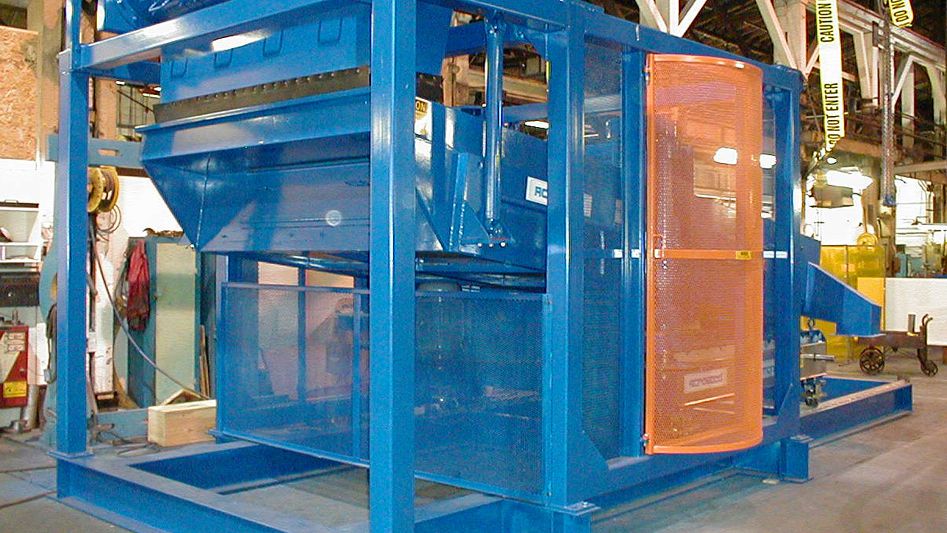
A
crowood’s Research and Development Center is located adjacent to its Everett, Washington manufacturing plant. For many years, the center has allowed Acrowood to accurately predict field performance of machinery by testing and evaluating equipment using customer supplied raw materials.
Acrowood’s long history and broad base of technology in chip processing means a mill can get answers to questions specific to their operation, in a way they can’t get anywhere else. Companies can estimate pay-back on equipment and will better know how their equipment will operate in the mill if they first test their materials in Acrowood’s pilot plant.

The pilot plant equipment is sized large enough to provide a more accurate prediction of field performance. Some machines are actual production models. The Acrowood Development Center includes two different chippers, a number of models of DiamondRoll screens, a Raised Roll Disc Screen, and a suspended rotary screen. A chip slicer, chip cracker, and an air density separator are also available for evaluation.
Testing capabilities include chipping (wood, bamboo, etc.), chip thickness screening, chip fines screening, urban wood screening and processing, particleboard furnish screening, hog fuel screening, high density contaminant removal, overthick chip cracking, and overthick chip slicing, as well as other less common applications.
Summary of Development Center Equipment
Disc Chipper
The Acrowood research Disc Chipper is composed of a 60“ chipper disc fit with 4 knives. The knives can be mounted in either face or clamp mount arrangements using knife mounting angels between 30° and 35°. The chipper is fit with a spout which can be adjusted both vertically and horizontally in a variety of positions to simulate many different kinds of spout arrangements.
The 300 horse power motor is sufficient to chip up to an 8 inch diameter log. The chips produced shoot out the back of the chipper into a cyclonic collector. Fines and dust which miss the collector chute are captured in a rectangular box at the bottom of the casing and can be removed separately.
The chipper is equipped with a variable speed drive system which allows operating speeds up to 600 RPM (10,500 feet per minute rim speed). The position of the spout can be altered from the inside to the outside edge of the knife for chipping position control. Chip lengths of 5/8” to 1-1/8” are possible.
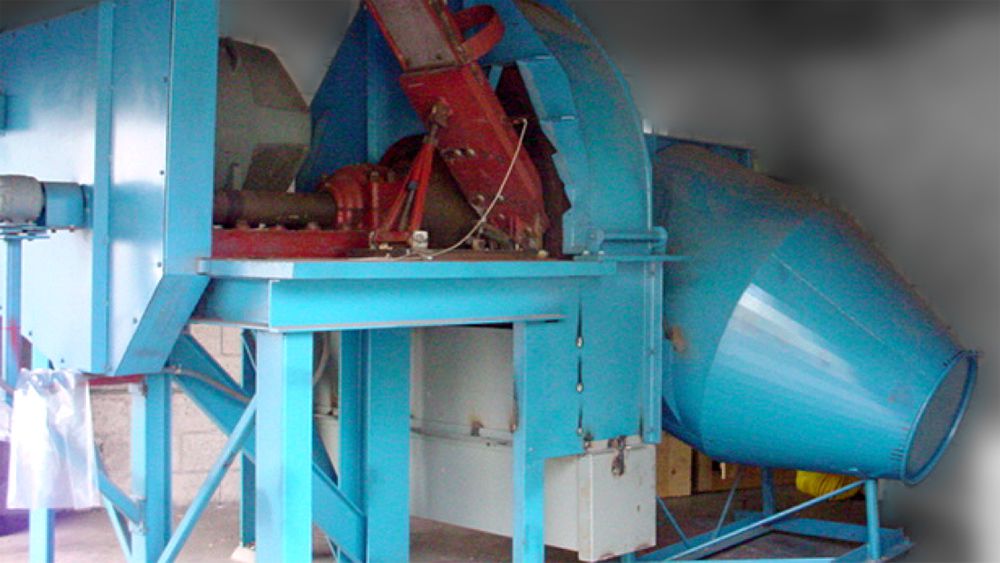
Raised-Roll Disc Thickness Screen
The Raised Roll Disc Thickness Screen is set with an IFO (Inter-facial opening) of 6.5 mm, and is not adjustable. The welded shafts are driven with a single motor. The shafts are belt driven in such a way that all of the shafts turn at the same speed. A variable speed drive controls the actual operation of the motor so that the screen can be run at any selected speed.
The two foot wide shafts are composed of welded stainless steel discs. The screen is mounted on legs so that the material which falls through can be collected in individual totes, or each of the individual nips can be isolated for a nip-by-nip analysis. The Raised Roll feature is popular because of its increased retention time, improved agitation, and improved capacity over traditional all-flat shaft arrangements.
The dedicated two foot wide star feeder holds about 2-3 drums of material for a particular test. The variable speed drive controller allows the star feeder to discharge at any desired rate.

DiamondRoll VIRO Thickness Screen
The DiamondRoll VIRO Thickness Screen is composed of 3.5 inch diameter shafts, just like a regular production machine. This two foot wide thickness screen can be set with an IRO between 5 and 25 mm (or larger if required). Typical chip thickness screening applications use between 6 and 10 mm as their IFO target.
The side frames and drive arrangement in the screen are just as they are in a production machine. This includes the sealed bearings, movable bearing housings separated by IFO-determining shims, and continuous loop chain drive systems.
The aluminum shafts resist corrosion and provide the long service life in a test environment. The shafts are driven by a single motor which is controlled by a variable speed drive controller so that the actual operating speed can be set for any particular requirement. A series of bins and hoppers can be placed below the screen so that material can be collected from the front to the back of the screen in discreet collection containers for length-wise analysis, or #1 and #2 accept zones can be created with their own collection totes.
It is possible to locate the Disc Thickness Screen above the Diamond Roll Thickness screen for two level pre-screening system control, if desired.

Trillium OSB Strand Screen
With the challenge of green screening, Acrowood has developed the patent-pending Trillium Screen. This screen agitates the fibers making the strands dance over the screen, liberating the fines. The three-sided disc shape achieves this without damaging strands. It handles a high loading rate with excellent surge suppression. The triangular shape of the discs provides great agitation. The large strands that topple and tumble over the surface of the screen will form the surface of the board while the undersized material passes through the screen’s 3mm IFO to a DiamondRoll VIRO Fines Screen below. This method allows fines to pass with the small strands while recovering good strands on the Diamond Roll.
The Acrowood DiamondRoll VIRO Fines Screen has the highest and most selective fines removal ever achieved under production conditions, lowest maintenance costs and downtime, best fiber recovery and earliest payback on fiber streams. The DiamondRoll’s Variable InterRoll Opening (VIRO) allows the spacing between the shafts to be set to meet the specific needs of the application.
With the fact that there are not two OSB mills that are alike; each mill’s process and strands are unique, this screening combination works due to its extreme versatility. Strand size, flow rate and downstream options are just a few examples of variables in the system. This includes the dependency on what efficiency the mill is looking for. With high variability, flexibility in our screening system is important. Specifications such as IFO, roll speed, screen angle, etc, can be manipulated to fit every mill’s needs.
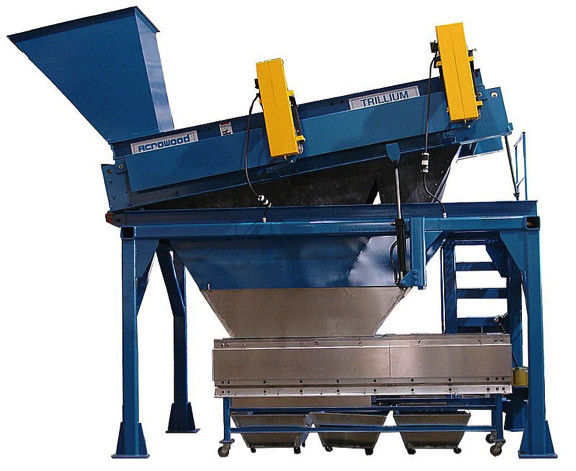
DiamondRoll VIRO Fines Screen
The Diamond Roll VIRO Fines Screen is a 40 shaft DiamondRoll fines screen, 4 feet wide. It can set with a minimum of 0.5 mm gap to a maximum of about 5 – 6 mm. There are a series of shafts available for this screen, from a small knurl of # 12 to a maximum of # 17, for a variety of fines and pins separation processes. A single motor drives all 40 shafts. The motor is controlled with a variable speed drive controller to provide any production condition requirement.
The star feeder above the DiamondRoll Screen holds 2-3 barrels of chips for a particular test. The material which passes through the DiamondRoll Screen can be dropped onto the floor for a continuous output evaluation, or a series of totes can be located below the screen to catch the fines rejected in zones from the infeed to the discharge end. It is also possible to locate a tote at the discharge of the screen to catch the overs as they fall off the last roll in the series.
This particular screen is an early prototype screen which has been modified to be capable of the VIRO feature (Variable Inter Roll Opening). This means that the original channel frame has been cut with a continuous slot and modified for the current style of bearing blocks, so that the shafts, bearings, and drive systems are similar to current production machines.
This DiamondRoll Fines Screen is used primarily for pulp and paper and sawmill style applications requiring fines to be removed from chips, and pin chips to be separated from fines. For particleboard and other engineered wood product applications the DiamondRoll Particle Screen is often a more practical choice. View more roll screens >

Chip Cracker
The Acrowood Chip Cracker used in the development center for testing is the prototype model originally designed to prove the concept of the Chip Cracker. The roll surfaces are cut in a style which is exactly the same as the field production units, although they are made from ½ thick steel drums mounted in a support shaft. The laboratory machine is composed of 2 independently supported swinging rolls with a hydraulic cylinder on each side providing compression force. It is possible to change the hydraulic pressure and compression force in the cracking process through a simple valve adjustment system. Typical pressure systems vary between 350 and 600 PSI line pressure which has seemed to provide ample range for demonstrating the effect of crush pressure on chip fissure development.
A series of shims placed behind the stop blocks allow the Cracker nip to be adjusted from a minimum of 2.5 mm with essentially an unlimited maximum. Running the hydraulic system in reverse allows the rolls to open to a maximum dimension of about 7 inches free space between the rolls. A dedicated 2 foot wide star feeder will hold about 1 drum of overs for any particular test. A variable speed drive controller permits feed rates between 0 and 10 units per hour of chips to feed into the 2 foot wide Cracker, which corresponds to generally expected maximum field capacities.
A collection container mounted on wheels below the rolls allows the cracked chips to be quickly captured and removed following any particular test.
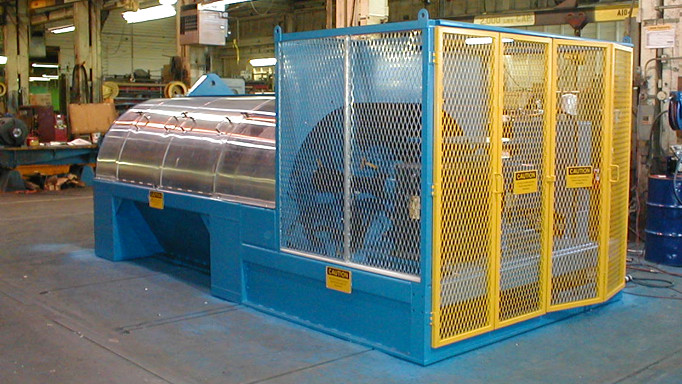
DiamondRoll VIRO Particle Screen
The DiamondRoll VIRO Particle Screen is one of the more versatile components in the Acrowood Development Center’s arsenal of machines. The standard configuration for the particle screen includes a front small knurl, small IRO section, followed by a medium knurl, small IRO section, followed by a large knurl, large IRO section, followed by scalping rolls, followed by rejection of the oversize. This typically 4-5 part separation is accomplished in a single screen bed. The aluminum catch tray mounted on wheels is located below the screen, and allows the individual samples to be collected in bins for sample collection and analysis.
Two separate drive controllers are used in the particle screen. One controls the front half of the screen so that it can be run at one speed with the second controlling the back half. This independent speed control allows the screen to compensate for diminished load conditions, high fines in the in feed material, or any other process parameter which may prove sensitive to roll speed.
A variety of styles of the 2 foot shafts are available for this screen including knurl patterns from 0.8 mm deep to 5.5 mm. This extreme range corresponds to various screening targets which the bins then capture for independent analysis.
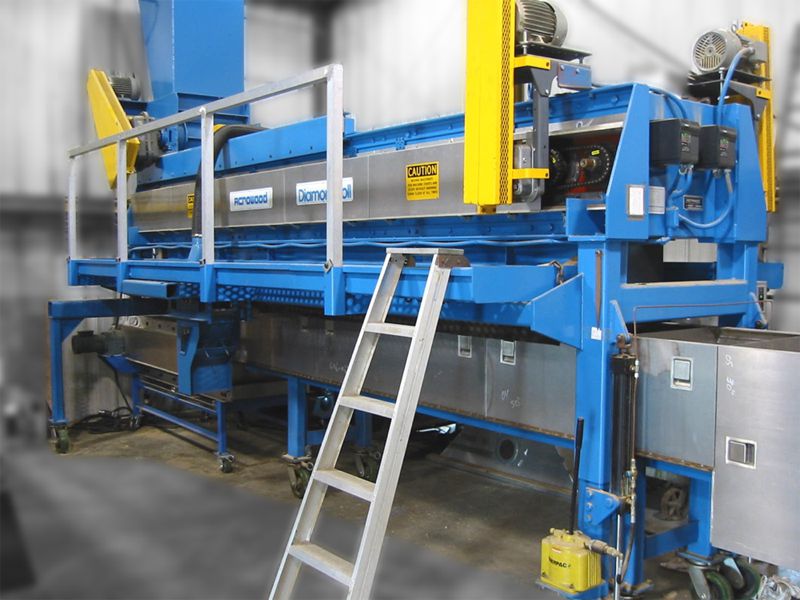

The 2 foot wide star feeder and hopper has been specially designed to contain finely granular particle materials for feed to the DiamondRoll Screen. The standard 6 vein feeder has been replaced with a 12 vein style to reduce the tendency for the large vein feeders to “pulse load” the screen. This is important especially at low load rates where the RPM of the feeder is quite low.
Ports are located in the chutework below the screen to allow dust collection systems to draw air from below. This reduces the tendency of the dry particulate materials to create a dust problem during testing.
It is also possible hook a large aluminum manifold system up in large zones below the screen and draw fairly substantial vacuum (with an additional air collection system) which has been necessary for some types of particulate testing. In some cases the light fluffy nature of a test material my preclude gravity being the motivating force for encouraging it to pass between the rolls. When this happens it is possible to draw a vacuum from below the screen, where movement of air between the rolls will encourage the passage of the fluffy material into the accept steam. In that case the dust collection system then captures the accepted product below a high efficiency cyclone located outside the building.
The infeed hopper is mounted on wheels. It can feed the screen from the very first roll position, or it can be moved down the screen length to feed to about the mid point of the screen. This allows the effective surface area of a particular test to be tailored to the production conditions expected in a mill environment. In many cases only the second half of the screen shafts are appropriate for the tests and in this way it is possible to by-pass the shafts in the first half.
DiamondRoll SuperFine Particle Screen
For some tests the objective is to remove very fine materials less than 0.5 mm in diameter. The SuperFine rolls accomplish this using a combination of tight spacing and a finely cut surface knurl pattern. The screen is typically used in conjunction with the DiamondRoll Particle Screen, where the raw material is pre-screened by the DPS. Only near-sized fractions are passed to the SuperFine rolls for processing. This screen is fit with integral collection pans for controlled sample collection and dust-free operation.
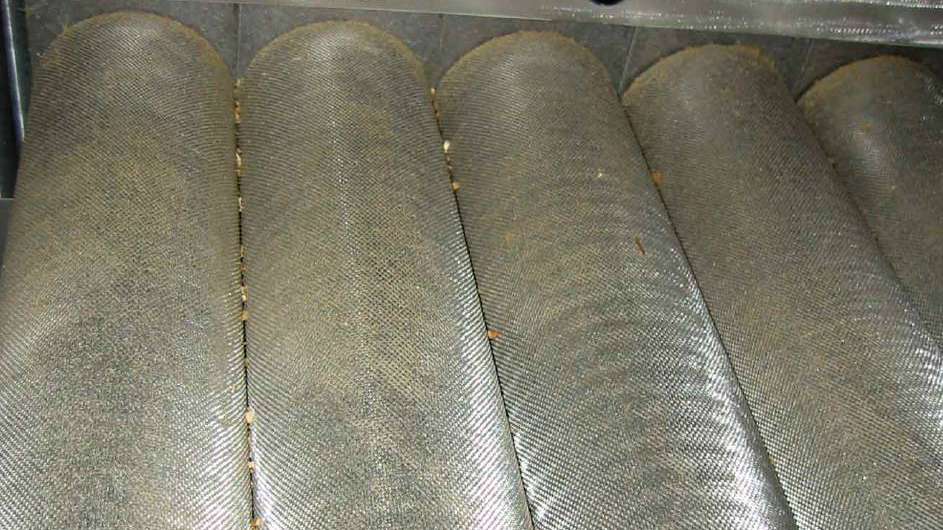
Dual Drive Suspended Rotary Screen
The Acrowood Dual Drive Suspended Rotary Screen is a 2 foot wide by 8 foot long double deck screen used for general shaker screen process testing. The top deck is held in place by a series of easily removed clamps. Hole sizes from 3/8 inch round hole to 2 inch square can be used in the top deck. Acrowood maintains a variety of carbon steel top decks for any particular application.
The fines deck is held in position with clamps and can accommodate both punched plate and wire mesh designs. We maintain a stock of stainless steel wire mesh screens from 4 to 20 mesh in size. The round hole punch plates range from 3/8 “round hole to 3 mm round hole.
A single drive motor drives the production style dual drive lines mounted to the side of the screen frame. The speed of the screen can be adjusted from 180 RPM to 350 RPM. The amplitude of motion is controlled by the counter weights mounted to the ends of the drive shafts, and can be varied between 7/8 and 1.5 “.
A dedicated two foot wide star feeder with a 2-drum capacity hopper above it feeds the dual drive screen. The variable speed controller allows the feeder to run any required loading rate.

Air Density Separator
This unit was originally set up on the grounds of Acrowood to demonstrate capacity and efficiency of the Air Density Separator we designed and developed. Eventually this unit was sold, and has been in operation for many years in New England.
Today we have reduced the lab ADS to the separation zone and associated feeder, connecting the air piping to the large dust collection system we employ. Testing is possible under a variety of conditions by varying loading rate, air flow, and air velocity during the test.
For the most part we are testing particleboard-type materials for contaminant removal. Pulp chip and overthick chip applications abound, and most tests occur in the immediate vicinity of the inquiring mill simply by visiting a local mill and observing the action of the production unit in operation.
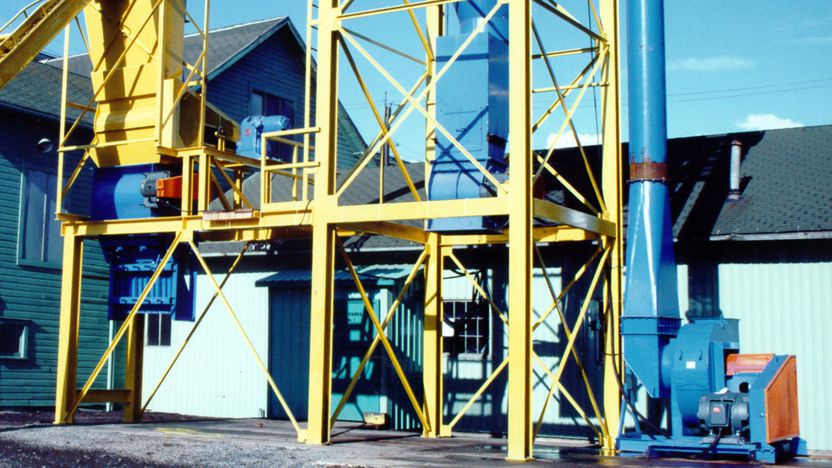
Chip Slicer
The Acrowood Chip Slicer in the development center is a full size production unit. The anvil rotor contains 11 anvils and knife rotor contains 15 knives all running in a counterclockwise direction. In every way this represents a full production capacity system.
For the Development Center the infeed conveyor is loaded with chips and the Slicer processes them as fast as they fall off the head pulley. In independent trials the Chip Slicer can handle up to 50 units of chips per hour without difficulty. The 125 horse power motor used in the lab has proven sufficient for any trials we have done in the past.
Gap settings are typically set to 6.5 mm to simulate mill conditions. A minimum gap setting of 2.5 mm has been used, with a maximum of about 12 mm. An adjustable gauge plate controls the slice thickness in the laboratory Chip Slicer.
The motor runs at a fixed speed and is not varied. The limited work done on slicer rotor speed control has been accomplished by belt and pulley changes. For the most part chip slicing technology has proven itself at our standard production rates of 129 RPM in the knife rotor and 370 RPM in the anvil rotor.
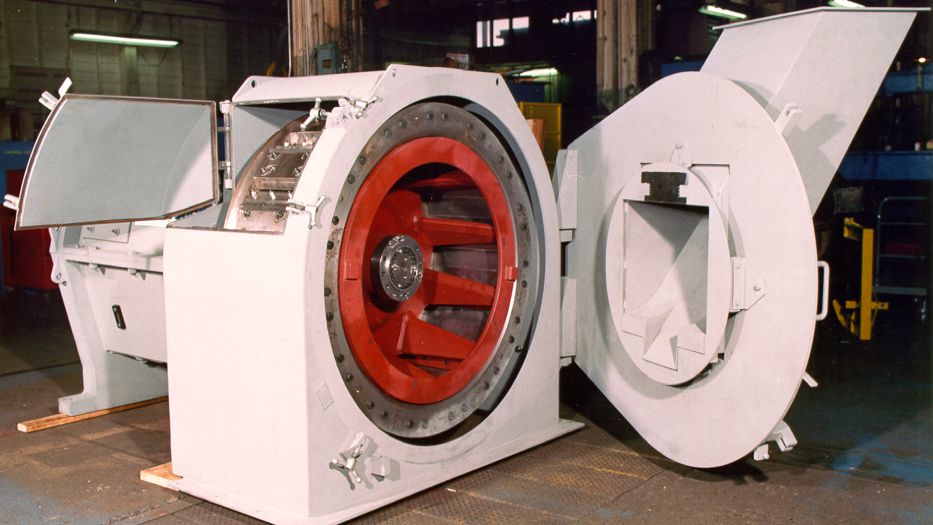
Slant Disc Chipper
Chip quality, installed costs and maintenance costs are the criteria by which all chippers should be measured. Yet they are rarely met by a single machine – until now. The Acrowood Slant Disc Chipper produces a high-yield, uniform chip quality with low capital investment and low maintenance cost. In fact, it is often cheaper to install a new Acrowood Slant Disc Chipper than to fix an old chipper that needs rebuilding.
The Acrowood 6120 Slant Disc Chippers’ unique “dead” shaft design allows the disc to be easily moved towards or away from the anvil. This provides a very tight set-up clearance between the knife and the anvil for excellent chip production with minimal pins and fines, excellent for producing uniform conventional pulp chips, mini- & macro-chips
Wastewood, rechipping, and small log chipping are accomplished using the 42″, 52″, and 61″ chippers, while large wastewood and whole log chipping are handled by the two 84″ models.

Sample Classification & Analysis
Acrowood’s development center includes the Stalsvets-style classifier, typified by the ChipClass. This series of stacked trays is typically used for chip and fines analysis screening in pulp and paper, sawmill, and many other industries. Acrowood possess screen trays ranging from 45 mm round hole, 10, 8, 6, 4 and 2 mm thickness trays, 7 mm and 3 mm round hole, and others. Typically a 5-7 tray series is used for most classifications.
Acrowood also has the Williams classifier series, and an Everett Metal Products (EMP) reciprocating classifier.
Acrowood also uses the Rotap particle classifier for most particleboard and OSB style classifications where very small particle sizes are used. We have a series of round classification trays ranging from 2 -40 mesh in size, with most intermediate sizes represented.
The Development Center also includes a small drying oven where sample moisture content can be determined.
